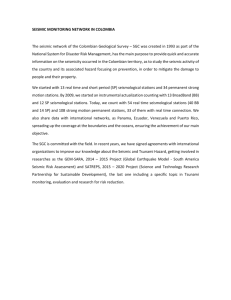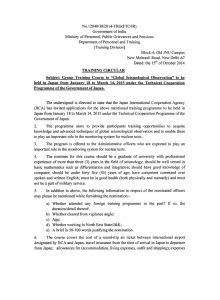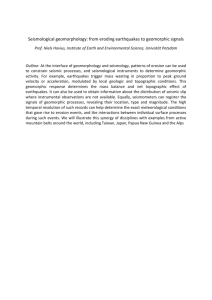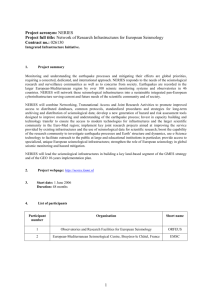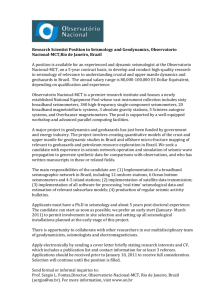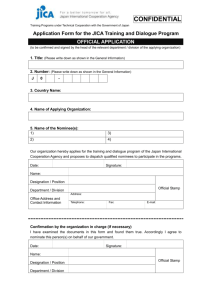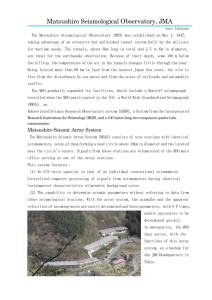TRAINING AND DIALOGUE PROGRAMS GENERAL INFORMATION
advertisement
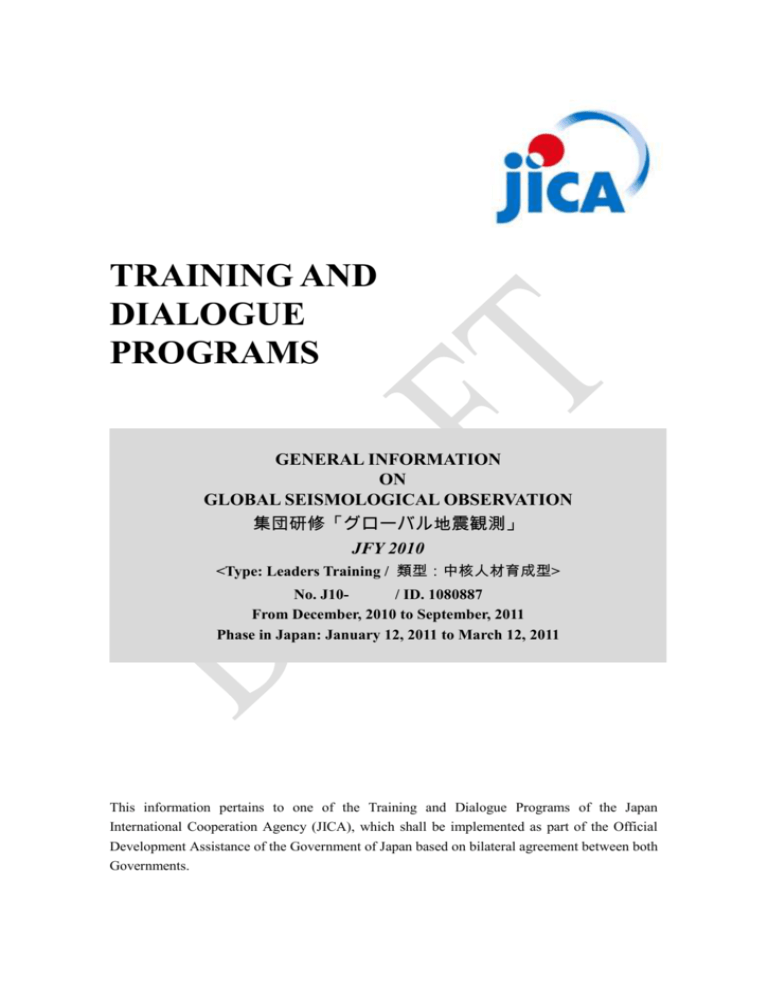
TRAINING AND DIALOGUE PROGRAMS GENERAL INFORMATION ON GLOBAL SEISMOLOGICAL OBSERVATION 集団研修「グローバル地震観測」 JFY 2010 <Type: Leaders Training / 類型:中核人材育成型> No. J10/ ID. 1080887 From December, 2010 to September, 2011 Phase in Japan: January 12, 2011 to March 12, 2011 This information pertains to one of the Training and Dialogue Programs of the Japan International Cooperation Agency (JICA), which shall be implemented as part of the Official Development Assistance of the Government of Japan based on bilateral agreement between both Governments. 1 I. Concept Background In September 1996, after difficult and exhaustive discussions/negotiations over a period of two and a half years, the Comprehensive Nuclear-Test-Ban Treaty (CTBT) was adopted with the support of an overwhelming majority of the international community. In order to secure the Treaty's verification regime, a global network of monitoring stations, comprised of seismological monitoring stations, is to be established to monitor nuclear tests. CTBT stipulates IMS (International Monitoring System) in order to verify the compliance of the treaty. Four kinds of monitoring and observation stations are to be set at 321 spots all over the world, and the data obtained at those stations are sent to the International Data Center in Vienna to be processed. Towards the early entry into force of the treaty, the Government of Japan made a decision to start an international cooperation in 2004 with the group training course in "Global Seismological Observation," which deals with seismological observation and its application for nuclear test monitoring technology ("Global Seismological Observation" and "Global Seismological Observation Ⅱ" were held during 1995-1998 and 1999-2003, respectively). This course is designed to introduce up-to-date technologies and knowledge in the field of global seismological observation to participants who are expected to play important roles in a global monitoring network for nuclear tests. For what? This program aims to acquire knowledge and advanced techniques of global seismological observation and is able to play important roles in the monitoring system for nuclear tests. For whom? This program is offered to the administrative officers who are expected to play important roles in a global monitoring network on nuclear tests. How? Participants shall have opportunities in Japan to acquire knowledge and advanced techniques of global seismological observation and is able to play important roles in the monitoring system for nuclear tests. Participants will also formulate an Action Plan describing what the participant will do after they go back to home country putting the knowledge and ideas acquired and discussed in Japan among others into their on-going activities. 2 II. Description 1. Title (J-No.): GLOBAL SEISMOLOGICAL OBSERVATION (J102. Period of program: Duration of whole program (1) Preliminary Phase: (in a participant’s home country) (2) Core Phase in Japan: (3) Monitoring Phase: ) December, 2010 to September, 2011 December, 2010 to January, 2011 January 12, 2010 to March 12, 2010 March, 2011 to September, 2011 3. Target Region or Country: 4. Eligible / Target Organization: This program is designed for a governmental organization which is expected to play important roles in a global monitoring network on nuclear tests. 5. Total Number of Participants: Ten (10) participants from above-mentioned target countries in total are expected to participate in this training program. 6. Language to be used in this program: English 7. Program Objective: The program objective is to be acquired knowledge and advanced techniques of global seismological observation for playing important roles in the monitoring system of nuclear tests under the CTBT. 8. Overall Goal: The overall goal is to strengthen the capacities of National Data Center (NDC) in the field of seismology and/or International Monitoring System (IMS) for contributing to the promotion for taking effect of Comprehensive Nuclear Test Ban Treaty (CTBT) in each country. 9. Outputs: Participants are expected to achieve the following outputs; (1) To acquire knowledge of the CTBT regime and the role of seismology in the 3 International Monitoring System (IMS) (2) To understand global seismological observation technologies for monitoring nuclear tests and earthquakes (3) To acquire data analytical techniques to discriminate nuclear tests from natural earthquakes (4) To Make an Action Plan (Project Proposal) which they should do in their country after a homecoming. 10. Expected Module Contents: This program consists of the following components. Details on each component are given below; (1) Preliminary Phase in a participant’s home country; (December, 2010 to January, 2011) Participating organizations make required preparation for the Program in the respective country. Outputs Activities To make an Inception Formulation and submission of Inception Report. Report. (2) Core Phase in Japan; (January 12, 2010 to March 12, 2010) Participants dispatched by the organizations attend the Program implemented in Japan. Output Subject Lecture/Exercise Contents Methodology To acquire CTBT & IMS Introduction of Review of verification of Lecture knowledge of CTBT Regime nuclear tests and the CTBT concerning seismology. regime and seismology Explanation of present the role of status and future plan of seismology in CTBT concerning the seismology International Characteristics Four different technologies Monitoring and Progress form the basis used by the System (IMS) Status of the International Monitoring International System (IMS) to verify Monitoring compliance with the System of the Comprehensive CTBTO Nuclear-Test-Ban Treaty (CTBT). The characteristics and status of implementation of each of 4 Lecture the networks -Seismic, Hydroacoustic, Infrasound and Radionuclide- with emphasis on the primary and auxiliary seismic networks will be presented. To understand Seismological Seismometer I Basic theory of Lecture and global electro-magnetic Practice Observation & II seismological seismometer and specific observation explanation for some broad technologies band seismograph. for Seismic Data acquisition and monitoring Network telemetry systems are nuclear tests Lecture overviewed. and Design of General guidelines for Lecture and earthquakes Seismic designing seismic network Presentation Network I & II are given on the first day. Participants will then make a plan to upgrade the seismic network of your country during the training course to make a presentation on the last day. Noise survey Practice in measurement of Lecture and and site ground tremor will be given Practice selection I & II with short-period sensors and a broadband sensor. National Data Auto Data The auxiliary stations under Center Request IMS network should send Manager seismograms by e-mail upon request from IDC. To realize this data transmission automatically, it is required to install Auto Data Request Manager (AutoDRM) at stations or National Data Center. In this lecture, we will review the Swiss 8AutoDRM system, which has been 5 Lecture widely used around the world since GSETT-3. The lecture includes the installation and maintenance of this AutoDRM system. National Data System and operation in Center (NDC) National Data Center Lecture (NDC) will be introduced. To acquire Data Retrieval of Practice of data retrieval Lecture and data Processing Digital Seismic and plotting seismograms Practice analytical Data and will be given. Then basic techniques to Disposal of theory and practice of data discriminate Format processing used frequently nuclear tests Spectral in the field of global from natural Analysis seismology will be given. earthquakes Digital Filter You will practice using broad and short-period seismograms of nuclear explosions and earthquakes. Data Analysis Introduction to The essentials and basic Lecture and UNIX commands of UNIX will be Practice explained. Installation of Installation of Linux Lecture and LINUX and Installation of SAC Practice SAC (Seismic Analysis Code) Analysis of Explanation of principles Teleseismic underlying the interpretation Practice waves of seismograms Lecture and Reading practice Hypocenter A method for determining a Lecture and Location hypocenter of a teleseismic Practice event will be explained as well as that of a local one. Practice of the hypocenter determination will be given using PC. Source The purpose of this lecture Lecture and Mechanism is to provide with necessary Practice basic knowledge for determination of focal 6 mechanism by seismic wave analysis. It includes a manual P-wave first motion method and moment tensor inversion. Seismic Array Objectives and history of Data Analysis seismic arrays Lecture Signal and noise in space and time Arrival time analysis Beamforming in time domain Frequency-wavenumber power spectrum Resolution Spatial sampling Design of an array station Observation and Introduction of Matsushiro Lecture and Practice of Seismological Observatory Practice Seismic Array Visit to a satellite station of MSAS (Matsushiro Seismic Array System) Practice: Analysis of seismograms obtained by MSAS Analysis using Practice of analyzing IDC Lecture and GEOTOOL waveforms using Practice GEOTOOL software. Seismicity and The characteristics and Lecture and Tectonics tectonic background of the Practice seismicity in the world are introduced and practice on analyzing seismicity is given by using personal computer. The nuclear Discrimination General introduction on Lecture and test by mb-Ms magnitudes, practice of Practice identifying determination of mb and method Ms, and discrimination by mb-Ms 7 Discrimination Explanation of short period Lecture and by short-period discriminates, practice of Practice seismograms discrimination by short period discriminates General Practice of the screening discrimination procedure along the stream technique line by using all knowledge Practice in this lecture course. To Make an Action Plan Making Action Making Action Plan Action Plan Plan (Project Presentation Proposal) Practice Making the Presentation of Presentation the Action Plan and which they Discussion should do in their country after a homecoming. (3) Monitoring Phase after returning home country; (March, 2011 to September, 2011) Participating organizations make required preparation for the Program in the respective country. Outputs Activities Methodology To implement an * Participants will share the Action Plan prepared in Presentation, Action Plan, and Japan, and the acquired knowledge and techniques in Discussion prepare and submit this training course to your organization and/or and Practice the Final Report. country. * Participants will elaborate/revise the Action Plan for solving the problem in your country through the results of above-mentioned presentation in your organization and/or country. * Participants report the progress of the Action Plan to TV the officials of BRI and JICA Tsukuba on TV Conference conference in three (3) months after leaving Japan. * Participants will formulate the Final Report Practice and described in the results/progress of Action Plan. Submission * The Final Report should be submitted to JICA overseas office in six months after leaving Japan. (* The deadline of submission for the Final Report is on September 12th, 2011) 8 【Structure of the Program】 Overall Goal ; The overall goal is to strengthen the capacities of National Data Center (NDC) in the field of seismology and/or International Monitoring System (IMS) for contributing to the promotion for taking effect of Comprehensive Nuclear Test Ban Treaty (CTBT) in each country. 3. Monitoring Phase after returning home country (○ To formulate the Final Report described in the results/progress of Action Plan.) ○ To report the progress of the Action Plan to the officials of BRI and JICA Tsukuba on TV conference in three (3) months after leaving Japan. ○ To share the Action Plan prepared in Japan to your organization and/or country. ⇒ To elaborate/revise the Action Plan for solving the problem in your country. (Submission of the Final Report) Program Objective ; The program objective is to be acquired knowledge and advanced techniques of global seismological observation for playing important roles in the monitoring system of nuclear tests under the CTBT. 2. Core Phase in Japan Output 4: To Make an Action Plan (Project Proposal) which they should do in their country after a homecoming. <Subject of training> Action Plan ・Making Action Plan, Presentation Output 2: To understand global seismological observation technologies for monitoring nuclear tests and earthquakes <Subject of training> Seismological Observation, National Data Center ・Seismometer, Seismic Network, Design of Seismic Network, Noise survey and site selection ・Auto Data Request Manager, National Data Center Output 3: To acquire data analytical techniques to discriminate nuclear tests from natural earthquakes <Subject of training> Data Processing, Data Analysis, The nuclear test identifying method ・Retrieval of Digital Seismic Data and Disposal of Format, Spectral Analysis, Digital Filter ・Introduction to UNIX, Installation of LINUX and SAC, Analysis of Teleseismic waves, Hypocenter Location, Source Mechanism, Seismic Array Data Analysis, Observation and Practice of Seismic Array, Analysis using GEOTOOL, Seismicity and Tectonics ・Discrimination by mb-Ms, Discrimination by short-period seismograms, General discrimination technique Output 1: To acquire knowledge of the CTBT regime and the role of seismology in the International Monitoring System. <Subject of training> Outline of CTBT & IMS ・Introduction of CTBT Regime concerning seismology ・Characteristics and Progress Status of the International Monitoring System of the CTBTO 1.Preliminary Phrase Formulation and submission of Inception Report. 9 III. Conditions and Procedures for Application 1. Expectations for the Participating Organizations: (1) This project is designed primarily for organizations that intend to address specific issues or problems identified in their operations. Applying organizations are expected to use the Program for those specific purposes. (2) In this connection, applying organizations are expected to nominate the most qualified candidates to address the said issues or problems, carefully referring to the qualifications described in section III-2 below. (3) Applying organizations are also expected to be prepared to make use of knowledge acquired by the nominees for the said purpose. 2. Nominee Qualifications: Applicants should: ・ be nominated by their governments. ・ be university graduates or the equivalent, with professional experience of more than three (3) years in the field of seismology. ・ ・ ・ ・ be well versed in basic mathematics such as differentiation and integration. have good knowledge of computer. be under forty-five (45) years of age. have a competent command of spoken and written English which is equal to TOEFL CBT 173 or more (This training program includes active participation in discussions and development of the action plan, thus requires high competence of English ability both in conversation and composition. Please attach an official certificate for English ability such as TOEFL, TOEIC etc, if possible) ・ be in good health, both physically and mentally, to participate in the Program in Japan. (* Pregnancy: Pregnant participants are strictly requested to complete the required procedures before departure in order to minimize the risk for their health. The procedures include ①letter of the participant’s consent to bear economic and physical risks ②letter of permission from the participant’s supervisor ③letter of consent from your Embassy in Japan, ④medical certificate. Please ask National Staffs in JICA office for the details.) ・ not be serving any form of military service. 10 3. Required Documents for Application: Following items should be submitted to JICA Office (or the Embassy of Japan) by November 19, 2010. (*NOTE: Applications without these items will be out of the selection process.) (1) Application Form: One (1) original and three (3) copies Regarding the Format of Application Form, please make contact with the respective countries’ JICA office. (2) Nominee’s English Score Sheet: To be submitted with the Application Form. If you have any official documentation of English ability (e.g., TOEFL, TOEIC, IELTS), please attach it (or a copy) to the application form. (3) Inception Report: Each applicant should prepare a report on the present situation of the following subject in their own countries in accordance with ANNEXⅠ. This Inception Report should be typewritten and submitted to JICA Office (or the Embassy of Japan) together with the application form. Title: Seismic Observation in your country Sections to be included; (1) Introduction, (2) Seismicity, (3) Organization, (4) Observational Network and Instruments (5) Data analyses performed in your organization, (6) Relation between your country and the International Monitoring System (IMS), (7) Future Plans 4. Procedure for Application and Selection: (1) Submitting the Application Documents: Closing date for application to the JICA Center in JAPAN: November 19, 2010. Note: Please confirm the closing date set by the respective countries’ JICA office or Embassy of Japan of your country to meet the final date in Japan. (2) Selection: After receiving the document(s) through due administrative procedures in the respective government, the respective countries’ JICA office (or Japanese Embassy) shall conduct screenings, and send the documents to the JICA Center in charge in Japan, which organizes this project. Selection shall be made by the JICA Center in consultation with the organizations concerned in Japan based on submitted documents according to qualifications. The organization with intention to utilize the opportunity of this program will be highly valued in the selection. (3) Notice of Acceptance: Notification of results shall be made by the respective countries’ JICA office (or Embassy of Japan) to the respective Government by no later than December 6, 2010. 11 5. Documents to be submitted by accepted participants: Before coming to Japan, only accepted participants are required to prepare the following materials; (1) Presentation material on Inception Report: Participants will be requested to make a presentation (about 20 minutes) and discuss on their Inception Report in group discussion session at the beginning of the training program. 6. Conditions for Attendance: (1) to observe the schedule of the program, (2) not to change the program subjects or extend the period of stay in Japan, (3) not to bring any members of their family, (4) to return to their home countries at the end of the program in Japan according to the travel schedule designated by JICA, (5) to refrain from engaging in political activities, or any form of employment for profit or gain, (6) to observe the rules and regulations of their place of accommodation and not to change the accommodation designated by JICA, and (7) to participate the whole program including a preparatory phase prior to the program in Japan. Applying organizations, after receiving notice of acceptance for their nominees, are expected to carry out the actions described in section II-10 and section III-5. 12 IV. Administrative Arrangements 1. Organizer: (1) Name: JICA Tsukuba 2. Implementing Partner: (1) Name: International Institute of Seismology and Earthquake Engineering (IISEE) at Building Research Institute (BRI) (2) Address: 1 Tachihara, Tsukuba-Shi, Ibaraki-ken, 305-0802 Japan (3) TEL: +81-29-879-0679, FAX: +81-29-864-6777 (4) E-mail: iisee@kenken.go.jp (5) URL: http://www.kenken.go.jp/english/index.html (6) Remark: IISEE is an organization that trains participants from earthquake-prone developing countries on Seismology and Earthquake Engineering. In 1962, the BRI established the IISEE as an institute exclusive for training in the field of seismology and earthquake engineering. 3. Travel to Japan: (1) Air Ticket: The cost of a round-trip ticket between an international airport designated by JICA and Japan will be borne by JICA. (2) Travel Insurance: Term of Insurance: From arrival to departure in Japan. 4. Accommodation in Japan: JICA will arrange the following accommodations for the participants in Japan: JICA Tsukuba International Center (JICA TSUKUBA) Address: 3-6 Koyadai, Tsukuba, Ibaraki 305-0074, Japan TEL: +81-29-838-1111, FAX: +81-29-838-1790 (where “81” is the country code for Japan, and “29” is the local area code) If there is no vacancy at JICA TSUKUBA, JICA will arrange alternative accommodations for the participants. 5. Expenses: The following expenses will be provided for the participants by JICA: (1) Allowances for accommodation, living expenses, outfit, and shipping (2) Expenses for study tours (basically in the form of train tickets). (3) Free medical care for participants who become ill after arriving in Japan (costs related to pre-existing illness, pregnancy, or dental treatment are not included) 13 (4) Expenses for program implementation, including materials For more details, please see p. 9-16 of the brochure for participants titled “KENSHU-IN GUIDE BOOK,” which will be given to the selected participants before (or at the time of) the pre-departure orientation. 6. Pre-departure Orientation: A pre-departure orientation will be held at the respective country’s JICA office (or Japanese Embassy), to provide participants with details on travel to Japan, conditions of the workshop, and other matters. 14 V. Other Information 1. Computer: The participants are recommended to bring own laptop/notebook computers and conversion adapter to prepare the Action Plan, presentation slides and to communicate by e-mail. The electrical current in Japan is 100 volts, 50 cycles, and the plug shape is A type. 2. Data for global seismological observation in your country: The participants are recommended to bring the relevant data concerning global seismological observation of your country in your laptop/notebook computers for preparing the Action Plan, presentation slides. END ANNEX-I: Instruction for the Preparation of Inception Report ANNEX-II: (For your information) Tentative Schedule of the program in Japan (JFY2010) ANNEX-III:(For your information) Relevant organization list in the field of CTBT 15 VI. ANNEX- I: Instructions for the Preparation on Inception Report JICA Group Training Course on Global Seismological Observation The Inception Report should be typewritten including items listed below. (1) Name of Applicant (2) Name of Organization to which Applicant belongs (*(1)-(2) are to be written on cover sheet as following sample shows.) (3) Title and Author’s Name (4) Summary The summary should be informative and include the principal findings and conclusions. References to formulas or figures are not necessary. It should not consist of more than 200 words. (5) Introduction (6) Affiliation of the Author Affiliation should appear as a footnote on the first page as following sample shows. (7) Topic * You might add Acknowledge and Appendix after the topic if necessary. (8) References References should have numbers in brackets in the order of their citation. (9) Attached Document Applicants are requested to submit attached documents including 3 items, - Information about the structure of Organization, for example, Organization Chart, - Research activity of Organization related to Seismology, Earthquake Engineering, or Seismic Hazard/Risk Analysis, and a list of governmental or private organizations related to Seismology or Earthquake Engineering in the country of Applicant. - Program for CTBT (Comprehensive Nuclear-Test-Ban Treaty) in your country (10) Download The template file that may make your editing task easier from http://iisee.kenken.go.jp/?p=public 16 Note; 1. The manuscript must be carefully prepared and should be submitted with the application form. The total pages of the Inception Report should not exceed 15 pages including tables and figures. 2. Page Format: Use A4 white paper sheets (21 cm x 29.7 cm). Leave 2.5 cm margins at the top, right and left sides of the text and 3.5cm margin at the bottom. Special attention has to be paid in preparing papers using US letter-size paper. It should be appropriately arranged so that it conforms to the above requirements in appearance, namely the manuscript should occupy 16cm x 23.7cm in each page. All main text should be single spaced, Times New-Roman types. Use 18pt in capital letters and boldface for TITLE, 12pt for authors, and 11pt for the rest, including affiliations, abstract, main text, headings, sub-headings, sub-subheadings, acknowledgement, appendix, references, and captions for figures, photos and tables. 3. Organization of the papers: Write the TITLE of your paper, centered and in 18pt capital letters and boldface types at the top of the first page. After two more line space, write your names in 12pt. Last names should be in capital. Affiliations should be cited by superscripts. Leave two lines, and then write abstract in 11pt. “ABSTRACT” should be in capital letters and boldface and be followed by the text of Abstract. After three lines, start main body of your paper in 11pt. The ordinary pages, starting from the second page, contain the main text from the top line. Avoid footnotes and remarks. Explain in the main text, or in Appendices, if necessary. Affiliation itself should be put at the bottom of the first page, cities, countries and e-mail addresses of all authors, as indicated above. 4. HEADINGS: Use at most three levels of headings, i.e., headings, subheadings and sub-subheadings. Headings shall be written in capital letters, boldface types, and centered of your text. Leave two lines space before headings and one after them. Do not indent the first line after headings, subheadings and sub-subheadings. First lines of the other text paragraphs should be indented as indicated here. Do not leave blank lines between paragraphs. Subheadings: Subheadings shall be written in lower-case letters and boldface types, right against the left side of your text, as indicated here. Leave one line space before and after subheadings. Use the above mentioned rules for indentation. Sub-subheadings: The only difference with respect to subheadings is that sub-subheadings shall be in Italic and no lines space shall be left after sub-subheadings. Don’t put numbering to heading of any level. 5. EQUATIONS AND SYMBOLS: Use high quality fonts for both mathematical equations and symbols. Papers with hand-written mathematical equations and symbols are not accepted. Equations should be centered and numbered. Leave one line above and below equations. The equation number, enclosed in parentheses, is placed flush right. Equations should be cited in the text as Eq. (1). 6. FIGURES, TABLES AND PHOTOS: Figures and tables shall be legible and well reproducible, and photos shall be clear. Colored figures, tables and photo will be printed in Black and White. Captions shall be written directly beneath figures and photos and above 17 7. 8. 9. 10. 11. 12. tables, and shall be numbered and cited as Figure 1, Table 1 or Photo 1. They should be written in 11pt, and centered. Long captions shall be indented. Do not use capital letter or boldface types for captions. Figures, tables and photos shall be set possibly close to the positions where they are cited. Do not place figures, tables and photos altogether at the end of manuscripts. Figures, tables and photos should occupy the whole width of a page, and do not place any text besides figures, tables and photos. Leave one line spacing above and bottom of figures, tables and photos. Do not use small characters in figures and tables. Their typing size should be at least 9pt or larger. UNIT: Use SI unit in the entire text, figures, and tables. If other units are used, provide it in parentheses after the SI unit as 2MPa (19.6 kg/cm2). CONCLUSIONS: Write a CONCLUSIONS section at the end of your paper, followed by ACKNOWLEDGEMENT, APPENDICES and REFERENCES. ACKNOWLEDGMENT: Acknowledgment should follow CONCLUSIONS. APPENDIX: Appendix should be placed between Acknowledgment and References, if any. REFERENCE: All references should be listed in alphabetical order of the first author’s family name. They are referred in the main text like (Gibson 1995a). Write the reference list as; Gutenberg, B., and Richter, C. F., 1954, Seismicity of the Earth and Associated Phenomena, 2nd ed. Princeton Univ. Press, Princeton, NJ. Richter, C. F., 1935, an instrument earthquake magnitude scale, Bull.Seis. Soc.Am.25, 1-32. Date of acceptance: This will be assigned after accepted for publication and added to the end of manuscript by Editorial Board. They should be written in parentheses in 9pt in boldface types. <Sample for Inception Report> 【Sample for the cover sheet】 【Sample for the first page】 THE GROUP TRAINING COURSE IN GLOBAL SEISMOLOGICAL OBSERVATION 2010 (COURSE ID: J10- TITLE OF THE INCEPTION REPORT by AUTHOR* ABSTRACT __________________ __________________ ) INCEPTION REPORT ON INTRODUCTION __________________ __________________ 1. Name of Participant 2. Name of Organization * The Author’s organization and occupation are to be written here. 18 VI. ANNEX- II: (For your information) Tentative Schedule of the program in Japan (JFY2010) Global Seismological Observation Course <January & February> Jan, 12 to Feb 7, 2011 19 <February & March> Feb, 8 to Mar, 12, 2011 Lecture Hour: 9:30 -12:00, 13:00 -15:30 Exception Mar. 1, 2, 3 9:30-12:00, 13:00-16:00 *This schedule and curriculum may be change. 20 VI. ANNEX- III: (For your information) Relevant organization list in the field of CTBT Target Country Organization Name 21 For Your Reference JICA and Capacity Development The key concept underpinning JICA operations since its establishment in 1974 has been the conviction that “capacity development” is central to the socioeconomic development of any country, regardless of the specific operational scheme one may be undertaking, i.e. expert assignments, development projects, development study projects, training programs, JOCV programs, etc. Within this wide range of programs, Training Programs have long occupied an important place in JICA operations. Conducted in Japan, they provide partner countries with opportunities to acquire practical knowledge accumulated in Japanese society. Participants dispatched by partner countries might find useful knowledge and re-create their own knowledge for enhancement of their own capacity or that of the organization and society to which they belong. About 460 pre-organized programs cover a wide range of professional fields, ranging from education, health, infrastructure, energy, trade and finance, to agriculture, rural development, gender mainstreaming, and environmental protection. A variety of programs and are being customized to address the specific needs of different target organizations, such as policy-making organizations, service provision organizations, as well as research and academic institutions. Some programs are organized to target a certain group of countries with similar developmental challenges. Japanese Development Experience Japan was the first non-Western country to successfully modernize its society and industrialize its economy. At the core of this process, which started more than 140 years ago, was the “adopt and adapt” concept by which a wide range of appropriate skills and knowledge have been imported from developed countries; these skills and knowledge have been adapted and/or improved using local skills, knowledge and initiatives. They finally became internalized in Japanese society to suit its local needs and conditions. From engineering technology to production management methods, most of the know-how that has enabled Japan to become what it is today has emanated from this “adoption and adaptation” process, which, of course, has been accompanied by countless failures and errors behind the success stories. We presume that such experiences, both successful and unsuccessful, will be useful to our partners who are trying to address the challenges currently faced by developing countries. However, it is rather challenging to share with our partners this whole body of Japan’s developmental experience. This difficulty has to do, in part, with the challenge of explaining a body of “tacit knowledge,” a type of knowledge that cannot fully be expressed in words or numbers. Adding to this difficulty are the social and cultural systems of Japan that vastly differ from those of other Western industrialized countries, and hence still remain unfamiliar to many partner countries. Simply stated, coming to Japan might be one way of overcoming such a cultural gap. JICA, therefore, would like to invite as many leaders of partner countries as possible to come and visit us, to mingle with the Japanese people, and witness the advantages as well as the disadvantages of Japanese systems, so that integration of their findings might help them reach their developmental objectives. 22 CORRESPONDENCE For enquiries and further information, please contact the JICA office or the Embassy of Japan. Further, address correspondence to: JICA Tsukuba International Center (JICA TSUKUBA) Address: 3-6 Koyadai, Tsukuba, Ibaraki 305-0074, Japan TEL: +81-29-838-1111 FAX: +81-29-838-1790
